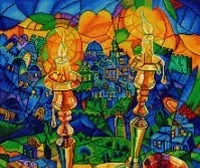Linking Shabbat with Tabernacle Construction
“The Torah portion of Vayakhel begins with a brief description of Shabbat, while then the rest of the portion deals exclusively with building the Tabernacle as commanded by God.
…Shabbat is mentioned here as a clear warning that building the Tabernacle does not supersede the sanctity of Shabbat. By juxtaposing Shabbat in the Tabernacle here and in a number of other places in the Torah, we are taught the fundamental connection between the types of work done in order to build the Tabernacle and the types of work that are forbidden on Shabbat.
…the juxtaposition of Shabbat and the Tabernacle is the basis of the oral tradition that there are thirty-nine primary types of creative work that are forbidden on Shabbat as they are the very types of creative work done in the Tabernacle. Yet the Torah only mentions two of them: making a fire, as described in this portion, [“You shall not kindle fire in any of your dwelling places on the Sabbath day” (Exodus 35:3)] and not travelling beyond a certain distance on Shabbat.
The Multidimensional Role of Fire
Therefore, not kindling fire becomes representative of not only all forbidden works on Shabbat but what fire symbolizes on many different planes of reality.
Fire manifests itself in many ways both positive and negative. Life through the ages and especially modern life is very much based on the ability to harness the element of fire and the parallel electromagnetic force. A few examples include heating and lighting our home, work and entertainment places, modes of transportation, modern ways of healing, industry and technology. Thus, not kindling light on Shabbat represents the full gamut of ceasing all the typical types of work forbidden on Shabbat.
… just like on the physical level, fire has many very positive uses and applications, so too spiritually. There is the positive fire of the soul and its natural tendency to flame upwards like a candle, always seeking to ascend spiritually. Just as we are not forbidden from using fire and light on Shabbat, rather not to kindle new light, using our already existing inner light is not only permitted but encouraged. We actually begin Shabbat by lighting candles right before Shabbat as a way to draw down new light before the Shabbat which will then inspire and enlighten the entire Shabbat experience.
…Shabbat is an opportunity to direct the natural and positive fire of the soul to flame upwards and connect to all of the spirituality and light that the soul longs to experience.
In the sefirot the element of fire is associated with the left side, the side of gevurah, might and strict judgment, whereas the element of water is associated with the right side, the side of chesed, lovingkindness. The command not to kindle light on Shabbat and all that it implies entails stepping back, minimizing and putting to rest the destructive feelings and thoughts connected to strict judgment.
This idea is beautifully expressed in the mystical passage from the Zohar that is recited by many congregations during the Kabbalat Shabbat Service at the beginning of Shabbat. Part of that passage reads as follows:
‘As Shabbat arrives, she merges into oneness, and is separated from the other side, and all strict judgments are severed from her. And she remains in unity with the holy light and crowns herself with many crowns for the holy King. Then all powers of wrath and all adversaries flee from her and vanish, and no other power rains in any of the worlds. Her countenance is irradiated with a supernal light, and she crowns herself here below with the holy people, all of whom are crowned with new souls.’”
– The above excerpts are provided by Emor exactly as they appear in the original source, without any modifications or corrections to typos. Text within square brackets, as well as subtitles and bold formatting, are added by Emor for emphasis, clarification, or commentary and do not change the original content.

